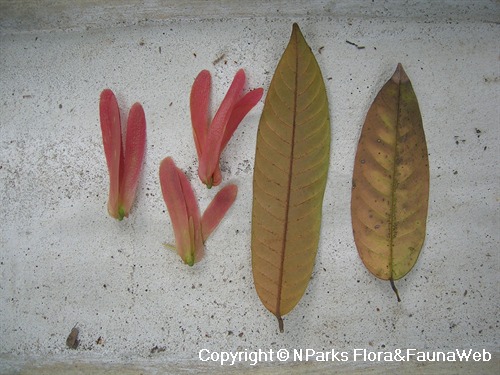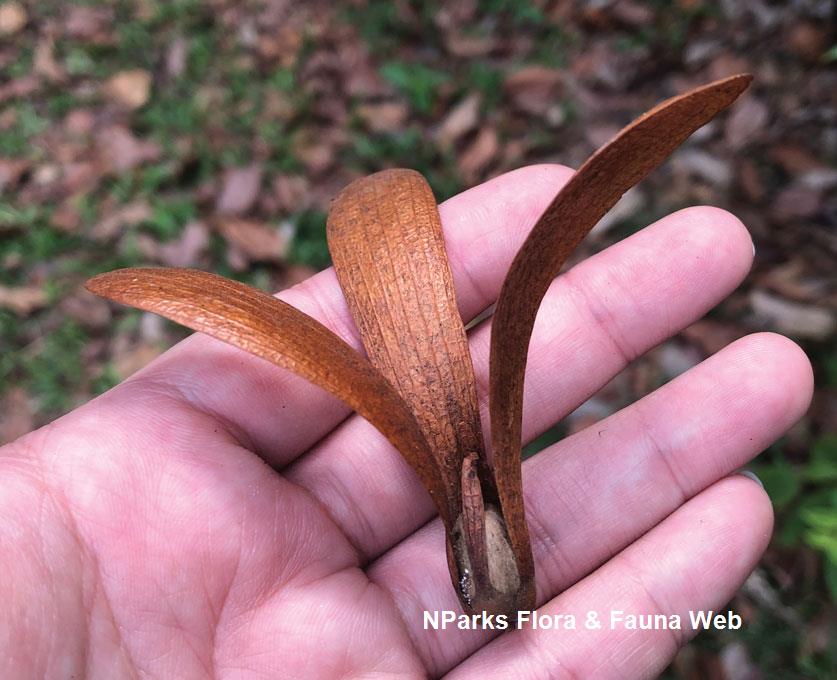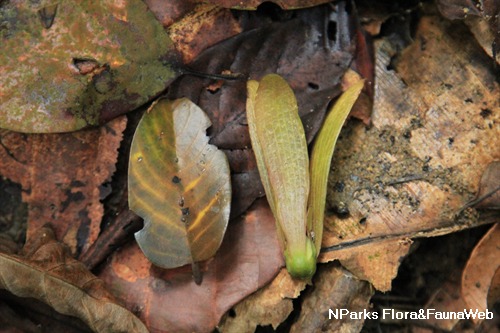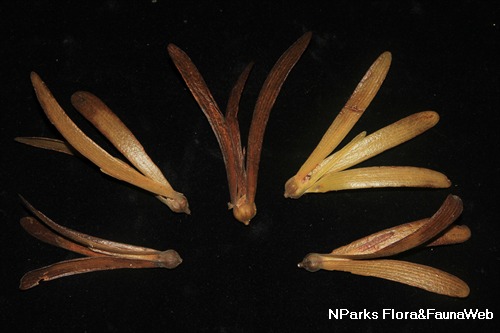
Back
Rubroshorea platycarpa (F.Heim) P.S.Ashton & J.Heck.
| Family Name: | Dipterocarpaceae |
| Synonyms: | Shorea platycarpa F.Heim, Shorea palustris Ridl. |
| Common Name: | Meranti Paya |
Rubroshorea platycarpa, also known as Meranti Paya, is a critically endangered tree in Singapore. It can reach up to 50 m tall and have a shallowly hemispherical crown as well as a deeply fissured bark. It produces pale-yellow resin and the wood can be used for both light and medium duty construction.
Name
Classifications and Characteristics
| Plant Division | Angiosperms (Flowering Seed Plants) |
|---|---|
| Plant Growth Form | Tree |
| Lifespan (in Singapore) | Perennial |
| Mode of Nutrition | Autotrophic |
| Plant Shape | Broad / Mushroom / Hemispherical |
| Maximum Height | 50 m |
Biogeography
| Native Distribution | Peninsular Malaysia, Indonesia and Borneo |
|---|---|
| Native Habitat | Terrestrial |
| Preferred Climate Zone | Tropical |
| Local Conservation Status | Native to Singapore (Critically Endangered (CR)) |
Description and Ethnobotany
| Growth Form | It is a tree, up to 50 m tall, and 1.2 m diameter. It has large buttresses that can reach up to 4 m tall and shallowly hemispherical crown. The bark is grey to pinkish brown and deeply fissured to crumbly flaky. It produces a pale-yellow resin, called dammar. Young branches are densely covered with brown persistent stiff hairs. |
|---|---|
| Foliage | The leaves are elliptic-oblong to broadly ovate (9 – 17 cm long and 5.5 – 10 cm wide), thinly leathery and in alternate arrangement. The leaf tip is pointed (up to 1 cm long) while the leaf base is obtuse leaf base. Each leaf has 16 – 20 pairs of lateral veins which are mostly straight and curved near the leaf margin. The midrib is almost flat above and prominent on the underside of the leaf. Young leaves have pale scale-like domatia along the midrib. The petiole is about 1.5 – 2 cm long and densely covered with brown persistent stiff hairs. |
| Flowers | Inflorescence is about 9 cm long, densely covered with brown persistent stiff hairs and occurs at the terminal ends or leaf axis. Flower have pale yellow petals and 15 stamens with sub-globose anther. The connectival appendage is as long as the anthers and gradually becoming reflexed. Ovary and stylopodium are narrowly ovoid. The style is about the same length as the ovary. |
| Fruit | Fruit is winged, dry and are borne almost without a stalk (subsessile). Each fruit comprises of three long calyx lobes (up to 6.5 cm long and 1.2 cm wide), two shorter lobes (up to 2 cm long) and one oval-shaped nut (0.8 cm long and 0.6 cm wide). The nut is densely covered with dull yellow-brown hairs. |
| Habitat | It is found in peat swamp forests. |
| Similar | Rubroshorea platycarpa is similar to Rubroshorea leprosula (synonym: Shorea leprosula) and differs in terms of the hairs on the underside of the leaf and numbers of lateral veins. On the underside of the mature leaf, R. platycarpa has sparse stiff hairs (scabrid) while R. leprosula has dense soft hairs (pubescent). In addition, R. platycarpa has 16 – 20 pairs of lateral veins while R. leprosula has 12 – 15 pairs. |
| Associated Fauna | Flowers are pollinated by insects. |
| Cultivation | It can be propagated by seed. |
| Etymology | The specific epithet platycarpa is Greek for flattened fruit, perhaps referring to the fruit calyx. |
| Ethnobotanical Uses | Timber & Products: The timber is used as light or dark red meranti. It is used for both medium or light duty construction such as flooring, furniture, door and window frames, rafters, weatherboarding and boat building. |
Landscaping Features
| Landscape Uses | Reforestation |
|---|
Fauna, Pollination and Dispersal
| Pollination Method(s) | Biotic (Fauna) |
|---|---|
| Seed or Spore Dispersal | Abiotic |
Plant Care and Propagation
| Light Preference | Full Sun |
|---|---|
| Water Preference | Moderate Water |
| Plant Growth Rate | Moderate to Slow |
| Rootzone Tolerance | Well-Drained Soils, Waterlogged Soils |
| Propagation Method | Seed |
Foliar
| Foliage Retention | Evergreen |
|---|---|
| Mature Foliage Colour(s) | Green |
| Mature Foliage Texture(s) | Leathery |
| Foliar Type | Simple / Unifoliate |
| Foliar Arrangement Along Stem | Alternate |
| Foliar Attachment to Stem | Petiolate |
| Foliar Shape(s) | |
| Foliar Venation | Pinnate / Net |
| Foliar Margin | Entire |
| Foliar Apex - Tip | Acuminate |
| Foliar Base | Rounded / Obtuse |
Non - Foliar and Storage
| Trunk Type (Non Palm) | Woody |
|---|---|
| Mature Bark Texture | Fissured, Peeling / Flaking / Papery |
| Stem Type & Modification | Woody |
| Root Type | Underground |
Floral (Angiosperm)
| Flower & Plant Sexuality | Bisexual Flowers , Bisexual Flowers |
| Flower Colour(s) | Cream / Off-White |
|---|
| Flower Grouping | Cluster / Inflorescence |
| Flower Location | Axillary, Terminal |
| Flower Symmetry | Radial |
| Individual Flower Shape | Saucer-shaped |
| Inflorescence Type | Panicle |
| Flowering Period | Every Few Years |
| Flowering Habit | Polycarpic |
Fruit, Seed and Spore
| Mature Fruit Colour(s) | Brown |
|---|---|
| Fruit Classification | Simple Fruit |
| Fruit Type | Indehiscent Dry Fruit , Samara |
| Seed Quantity Per Fruit | Few (1-5) |
References
| References | Ashton, P.S. (1982). Dipterocarpaceae. In: van Steenis, C.G.G.J. (ed.) Flora Malesiana, ser.1, vol. 9, part 2, pp. 237–552, 575–600. The Hague/Boston/London: Martinus Nijhoff/Dr. W. Junk Publishers. Ashton, P.S. (2004). Dipterocarpaceae. In: Soepadmo, E., Saw L.G. & Chung, R.C.K. (eds) Tree Flora of Sabah Sarawak, vol. 5, pp. 63–388. Malaysia: Forest Research Institute Malaysia (FRIM)/Sabah Forestry Department/Sarawak Forestry Department. Ashton, P.S. & Heckenhauer, J. (2022). Tribe Shoreae (Dipterocarpaceae subfamily Dipterocarpoideae) finally dissected. Kew Bull. 77: 885–903.Keng, H. (1990). The Concise Flora of Singapore: Gymnosperms and Dicotyledons. Singapore: Singapore University Press. |
|---|
Image Repository
Others
| Master ID | 30414 |
|---|---|
| Species ID | 4723 |
| Flora Disclaimer | The information in this website has been compiled from reliable sources, such as reference works on medicinal plants. It is not a substitute for medical advice or treatment and NParks does not purport to provide any medical advice. Readers should always consult his/her physician before using or consuming a plant for medicinal purposes. |

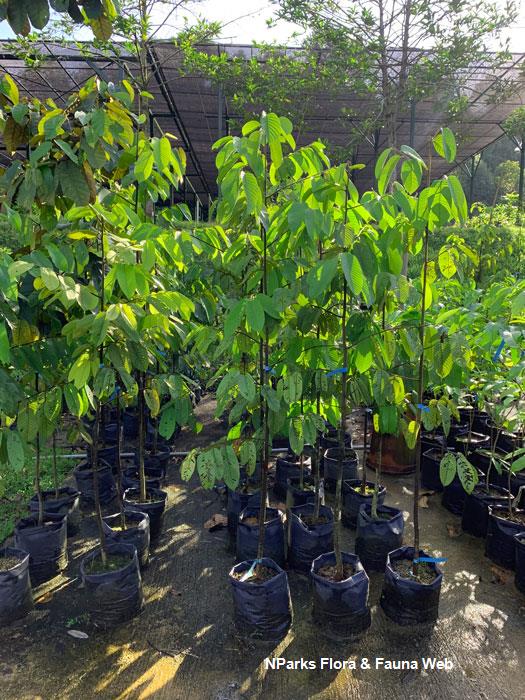
_lowres.jpg)
.jpg)
.jpg)
_lowres.jpg)
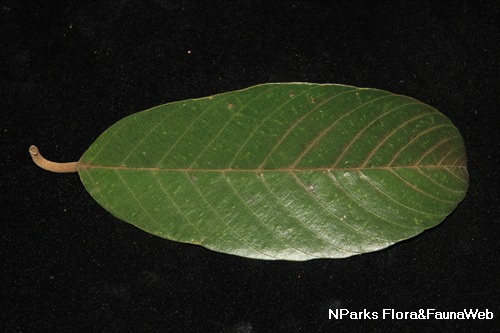
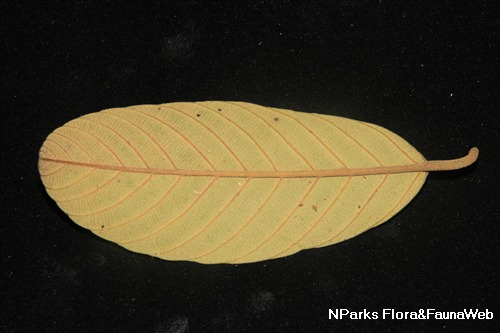

_lowres.jpg)
.jpg)
